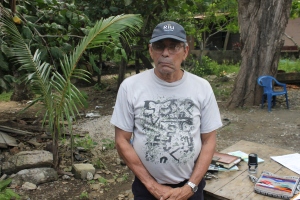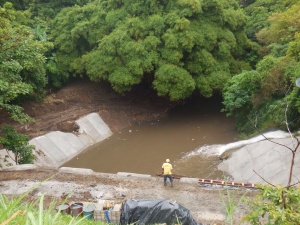SAN JOSÉ, Costa Rica – Situated on Costa Rica’s central Pacific Coast is the small community and wildlife preserve of Playa Ostional. Famous as the destination of the Olive Ridley turtles’ arribadas, the town also works toward sustainability, including the management of its water resources.
Tomás Chavarría, president of the community-managed water service in Ostional, said the water in the region is a “controlled experiment,” with water quality assessments completed every three months. He said the main problem in Ostional is funding for water service to the poorer parts of the community.
When Ostional does have water contamination though, it originates from other towns higher up in the mountains of Costa Rica, Chavarría said. Sometimes waste from septic tanks overflowing at higher elevations reaches all the way to Ostional, which is at sea level.
Rodrigo Morera, resident biologist in Ostional, said wastewater pollution has not affected the Ostional community directly, but when there is bad weather that causes river waters to rise, the contaminated water flows into the ocean. This polluted water can stop an arribada, the arrival of hundreds of thousands of turtles to lay their eggs, Morera said.
While Ostional may be less affected by water pollution than other parts of Costa Rica, the country’s water troubles are causing its green reputation to sink. Though booming in ecotourism and conservation efforts, Costa Rica still has a long road ahead in cleaning its water. No federally-operated sewage treatment facilities exist and waste regulations have not been enforced, water experts say.
The background
María Chavez, an industrial and environmental chemist at Universidad Nacional (UNA) in Heredia, tests water samples for a living. She cites the Environmental Performance Index, a compilation of assessments through Yale and Columbia universities, ranking countries’ greenness. According to the report, Costa Rica recently dropped from a fourth ranking to fifty-fourth after the EPI added water quality to assessment criteria.
UNA is working with Costa Rica’s health department (Ministerio de Salud) to verify test results of the water quality of the country’s rivers. Chavez tests the results to ensure they haven’t been tampered with, something that has occurred in the past, prompting the health department to make water regulations. Private parties have been known to take water samples and have them purified at laboratories to pass off as clean samples, she said.
According to Rafael Monge Vargas, professional adviser for the vice ministry of Water, Seas, Coasts and Wetlands in the Ministry of Environment, Energy and Telecommunications (MINAE), the Costa Rican federal government is still constructing its first wastewater treatment plant. By law, private companies are required to have their own sewage treatment centers, Monge said, and houses without a sewage line are required to have septic tanks serviced by licensed companies that collect the waste, he said.
Most of the raw sewage in Costa Rica flows directly into rivers. Costa Ricans haven’t concerned themselves with water apart from the water they consume, Monge said.
The politics of water
While water purification is a necessary solution, it is difficult and expensive to do if contamination levels are too high. Regulations would lower contamination levels, making the water easier to purify, Chavez said, and industrial contaminants going into the river are the first thing that needs to be regulated.
But first the political viewpoint on the regulation of water must be changed, Chavez said, especially among larger, transnational companies. This is difficult to do, she said, because of their size.
The federal government has money set aside through a law called Reglamento del Canon Ambiental por Vertidos. This law mandates that companies pay a fee for their waste disposal. The money collected from these fees is supposed to be allocated to water research and projects. The rates are $0.22 per kilogram of chemical waste and $0.19 per kilogram of solid waste. According to Chavez, the money collected has not been used even though it’s a significant amount.
“It’s very frustrating because they can do so much with that money, and it’s just sitting there,” she said.
The Tárcoles and other rivers
Chavez did a study on the Tárcoles River last year and found E-coli and other bacteria in the water, indicating major contamination problems. River pollution is measured by the number of fecal particles. According to Monge, a river is considered polluted if it has more than 5,000 fecal particles per 100 milliliters of water. Sewage from San José goes into the Tárcoles, and the river also flows through an industrial area where more waste is dumped, Chavez said. The pollution of this basin is a result of all the waste-ridden rivers dumping into Tárcoles.
Tárcoles isn’t the only river that is a dumping basin for Costa Rica’s untreated sewage. The Moraca River, Tempisque River and Limoncito are other heavily-contaminated rivers, according to Monge. Contamination in these rivers is also a result of large-scale agriculture. Banana and pineapple plantations in the Caribbean side of Costa Rica pollute nearby rivers with pesticides. Fertilizer is another major contaminant in Costa Rica’s rivers, Monge said.
Fauna, flora and grasses are most directly affected by the polluted rivers, Chavez said. “Everything’s a cycle. Everyone’s affected.”
Pianguas, a type of clam, absorb the toxins of contaminated water, which people ingest when they eat the clams, Monge said.
Costa Rica’s wastewater problem is also affecting the country’s hydroelectric energy production, which accounts for 75 to 85 percent of Costa Rica’s energy, Monge said. One of the country’s water basins, Reventazón, has two dams: Cachí and Angostura. When the water that pours into these dams is contaminated, the electric generator becomes inefficient, he said.
Mejoramiento Ambiental de la GAM y San José
Costa Rica is currently constructing a wastewater treatment facility in San José: Mejoramiento Ambiental de la GAM y San José, informally known as “Los Tajos.” According to Edgar Brenes Valenciano, director of institutional communication at Acueductos y Alcantarillados (AyA), the project began in 2008 during the administration of Oscar Arias.
However, in 2010, it was on hiatus under Laura Chinchilla’s administration because people who live in Carpio, near the project site, expressed concern about bad odors that could emanate from the plant, Brenes said. Carpio residents already have a landfill in their backyard.
“We’ve been explaining to them that it doesn’t involve bad smells, and in fact, it’s going to help them in the sense that the sewage coming from Carpio would be treated,” Brenes said.
According to Brenes, the Japanese government funded the expropriation of private lands and the project design. AyA could not provide exactly how much the project costs, but according to a 2012 press release from Acciona Agua, the Spanish company that was awarded the construction contract, the “Los Tajos” wastewater treatment plant is a $45 million project that is part of the larger San José Environmental Improvement Project, which ultimately aims to reduce the amount of untreated wastewater to .1 percent at a total cost of about $290 million.
Projected to be completed in 2018, the facility will be located in San José, Brenes said, and will serve 17 cantons. It will benefit all of Costa Rica by treating contaminated water and creating more potable water, he said.
Chavez said through education and research, UNA is trying to promote awareness throughout the community about wastewater treatment.
“In Costa Rica, there’s a lack of water treatment culture,” Monge said.


Good article on waste management.
Posted by Tyler Bivens | August 19, 2014, 11:46 pm